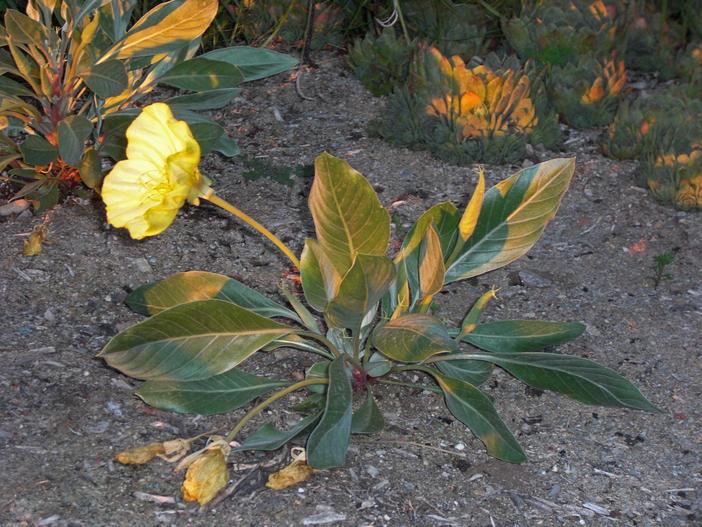Bigfruit Evening Primrose
(Oenothera macrocarpa subsp. incana)
Bigfruit Evening Primrose (Oenothera macrocarpa subsp. incana)
/
/

Andrey Zharkikh
CC BY 2.0
Image By:
Andrey Zharkikh
Recorded By:
Copyright:
CC BY 2.0
Copyright Notice:
Photo by: Andrey Zharkikh | License Type: CC BY 2.0 | License URL: https://creativecommons.org/licenses/by/2.0/ | Uploader: AndreyZharkikh | Publisher: Flickr







Estimated Native Range
Summary
Oenothera macrocarpa subsp. incana, commonly known as Bigfruit Evening Primrose, is a semi-evergreen perennial herb native to rocky prairies and glades of the Central United States, particularly in Missouri. It typically grows to a height of 0.4-0.7 feet (0.1-0.2 meters) and spreads 1-2 feet (0.3-0.6 meters). This plant forms a low, sprawling mound with a woody base and features large, cup-shaped, bright yellow flowers that bloom profusely from late spring to early summer, with sporadic continued flowering into fall. The flowers are quite showy and open in the evening, hence the common name. The foliage is lance-shaped and covered with soft hairs, giving it a grayish appearance.
Bigfruit Evening Primrose is valued for its drought tolerance and showy flowers, making it an excellent choice for rock gardens, border fronts, and native plant gardens. It is also used in xeriscaping due to its low water requirements. This plant thrives in full sun and well-drained soils, and it is relatively low-maintenance once established. While it is not commonly afflicted by diseases or pests, overwatering or poor drainage can lead to root rot. It is also important to note that this plant can spread quite readily by seed, which should be considered when planting in small garden spaces.CC BY-SA 4.0
Bigfruit Evening Primrose is valued for its drought tolerance and showy flowers, making it an excellent choice for rock gardens, border fronts, and native plant gardens. It is also used in xeriscaping due to its low water requirements. This plant thrives in full sun and well-drained soils, and it is relatively low-maintenance once established. While it is not commonly afflicted by diseases or pests, overwatering or poor drainage can lead to root rot. It is also important to note that this plant can spread quite readily by seed, which should be considered when planting in small garden spaces.CC BY-SA 4.0
Plant Description
- Plant Type: Herb
- Height: 0.4-0.7 feet
- Width: 1.3-2 feet
- Growth Rate: Moderate
- Flower Color: Yellow
- Flowering Season: Spring
- Leaf Retention: Semi-deciduous
Growth Requirements
- Sun: Full Sun
- Water: Low
- Drainage: Fast
Common Uses
Bee Garden, Bird Garden, Butterfly Garden, Deer Resistant, Drought Tolerant, Fragrant, Groundcover, Hummingbird Garden, Low Maintenance, Rabbit Resistant, Showy Flowers
Natural Habitat
Rocky prairies and glades of the Central United States, particularly in Missouri
Other Names
Common Names: Bigfruit Evening-Primrose, Bigfruit Eveningprimrose
Scientific Names: , Oenothera macrocarpa subsp. incana, Oenothera macrocarpa var. incana, Oenothera missouriensis var. incana,
GBIF Accepted Name: Oenothera macrocarpa subsp. incana (A.Gray) W.L.Wagner